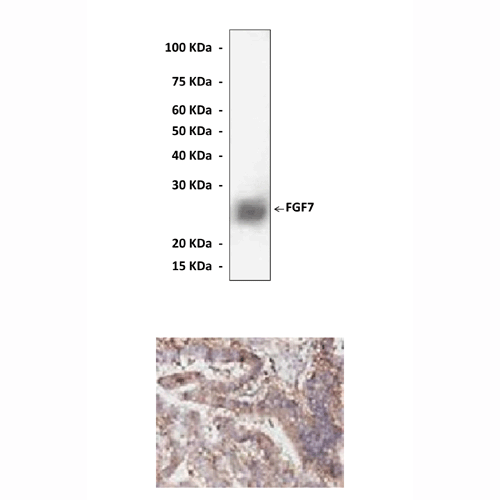Anti-FGF7: Polyclonal Fibroblast Growth Factor 7, KGF, Antibody |
 |
BACKGROUND FGFs comprise a large family of proteins that includes at least 22 known members. FGFs bind and signal through low and high affinity FGF receptors. The four known high affinity receptors (FGFR1–4) are structurally similar transmembrane receptor tyrosine kinases. FGF family members possess broad mitogenic and cell survival activities, and are involved in a variety of biological processes, including embryonic development, cell growth, morphogenesis, tissue repair, tumor growth and invasion.1
FGF7, also known as keratinocyte growth factor, or KGF, is a 28kDa member of the FGF Family. Amongst the known FGFs, FGF7 and FGF10 are unusual in that they have a stromal origin and appear to act specifically on epithelial cells and are therefore exclusively paracrine growth factors. This is in contrast to other family members, such as FGF1 and FGF2, which target fibroblasts as well as epithelial cells and may act in both an autocrine and paracrine fashion. FGF7 binds and activates a splice variant of the FGF receptor (FGFR) 2. Alternative splicing of the C-terminal half of the third immunoglobulin-like domain changes the ligand-binding properties for FGFR2, leading to FGFR2-IIIb binding specifically to FGF10 and FGF7, and FGFR2-IIIc interacting preferentially with FGF1 and FGF2. Whereas epithelial cells express FGFR2-IIIb, cells of mesenchymal origin express FGFR2-IIIc and this is found to be the case in most epithelial organs, including the breast.2
FGF7 has been demonstrated to be an active stimulus in wound healing and highly expressed in keratinocytes. FGF7 is expressed in other epithelial tissues, including gastrointestinal epithelium, transitional urothelial cells, and type II pneumocytes. Its expression is increased in the setting of inflammatory bowel disease, has been proposed as a potential tumor marker, and has been shown to protect epithelial cells from toxicity from reactive oxygen derivatives. Moreover, FGF7 plays critical role in maintaining gastric mucosa integrity, and FGF7 protein levels are regulated mainly by posttranscriptional mechanisms. The elevated FGF7 protein levels in gastric inflammation and gastric cancer, together with the known oncogenic potential of FGF7, implicate excessive FGF7 signaling in gastric tumorigenesis, and point to FGF7 as an attractive target for gastric cancer prevention and treatment.3 Additionally, FGF7 has been considered as an agent to treat oral mucositis. It was shown that FGFR2b/FGF7 signaling regulates terminal bud proliferation and branching of salivary glands in organ culture.
FGF7, also known as keratinocyte growth factor, or KGF, is a 28kDa member of the FGF Family. Amongst the known FGFs, FGF7 and FGF10 are unusual in that they have a stromal origin and appear to act specifically on epithelial cells and are therefore exclusively paracrine growth factors. This is in contrast to other family members, such as FGF1 and FGF2, which target fibroblasts as well as epithelial cells and may act in both an autocrine and paracrine fashion. FGF7 binds and activates a splice variant of the FGF receptor (FGFR) 2. Alternative splicing of the C-terminal half of the third immunoglobulin-like domain changes the ligand-binding properties for FGFR2, leading to FGFR2-IIIb binding specifically to FGF10 and FGF7, and FGFR2-IIIc interacting preferentially with FGF1 and FGF2. Whereas epithelial cells express FGFR2-IIIb, cells of mesenchymal origin express FGFR2-IIIc and this is found to be the case in most epithelial organs, including the breast.2
FGF7 has been demonstrated to be an active stimulus in wound healing and highly expressed in keratinocytes. FGF7 is expressed in other epithelial tissues, including gastrointestinal epithelium, transitional urothelial cells, and type II pneumocytes. Its expression is increased in the setting of inflammatory bowel disease, has been proposed as a potential tumor marker, and has been shown to protect epithelial cells from toxicity from reactive oxygen derivatives. Moreover, FGF7 plays critical role in maintaining gastric mucosa integrity, and FGF7 protein levels are regulated mainly by posttranscriptional mechanisms. The elevated FGF7 protein levels in gastric inflammation and gastric cancer, together with the known oncogenic potential of FGF7, implicate excessive FGF7 signaling in gastric tumorigenesis, and point to FGF7 as an attractive target for gastric cancer prevention and treatment.3 Additionally, FGF7 has been considered as an agent to treat oral mucositis. It was shown that FGFR2b/FGF7 signaling regulates terminal bud proliferation and branching of salivary glands in organ culture.
REFERENCES
1. Turner, N. & Grose, R.: Nat. Rev. Cancer 10:116-29, 2010
2. Palmieri, C. et al: J. Endocrinol. 177:65-81, 2003
3. Shaoul, R. et al: Biochem. Biophy. Res. Commun. 350:825-33, 2006
2. Palmieri, C. et al: J. Endocrinol. 177:65-81, 2003
3. Shaoul, R. et al: Biochem. Biophy. Res. Commun. 350:825-33, 2006
Products are for research use only. They are not intended for human, animal, or diagnostic applications.
Параметры
Cat.No.: | CA0853 |
Antigen: | N-terminal sequence of human FGF7 |
Isotype: | Affinity-Purified Rabbit Polyclonal IgG |
Species & predicted species cross- reactivity ( ): | Human, Rabbit, Rat, Mouse |
Applications & Suggested starting dilutions: | WB 1:500 to 1:1000 IP n/d IHC (Paraffin) 1:50 to 1:200 ICC n/d FACS n/d |
Predicted Molecular Weight of protein: | 26 kDa |
Specificity/Sensitivity: | Anti-FGF7 reacts specifically with FGF7 of human, rabbit, mouse & rat origin in Immunostaining and western blotting, no cross-reactivity with other members of the family. |
Storage: | Store at 4° C for frequent use; at -20° C for at least one year. |
*Optimal working dilutions must be determined by end user.
Документы
Информация представлена исключительно в ознакомительных целях и ни при каких условиях не является публичной офертой








